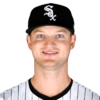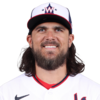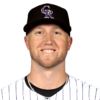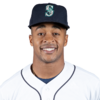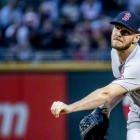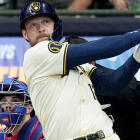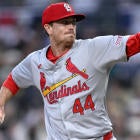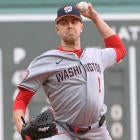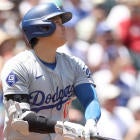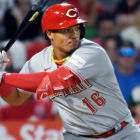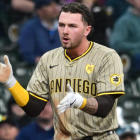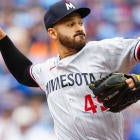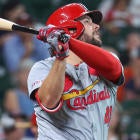For more Fantasy baseball insights, and to keep up with all the latest news, roster trends and more throughout the season, subscribe to Fantasy Baseball Today now on iTunes, Stitcher or Spotify. You can find us on YouTube now, with full episodes and clips available every Monday through Friday.
With April behind us, we now have enough data to compare league-wide stats from this season with the first months of previous years. Here's where things stand:
YEAR | AVG | OBP | SLG | K% | BB% | HR/FB% | R/G | SB/G |
2019 | 0.245 | 0.321 | 0.421 | 23.3 | 9.2 | 14.4 | 4.63 | 0.49 |
2018 | 0.244 | 0.319 | 0.4 | 22.7 | 9 | 11.9 | 4.47 | 0.52 |
2017 | 0.247 | 0.317 | 0.407 | 21.6 | 8.7 | 12.8 | 4.42 | 0.54 |
How much should we adjust our Fantasy strategy to account for the changing league context? In most cases, not by much. Most changes are small and affect all players similarly. If league strikeouts go up, for example, that means the number of strikeouts you'll need to win the category will go up, but it also means that nearly every available pitcher should have a slightly higher strikeout rate. If league runs go up, you'll need higher totals to win runs and RBI, but all hitters should see a slight boost to both numbers.
Steals would seem to be a different story, as there's reason to believe that a drop in total steals doesn't affect all players equally. Stealing bases is an intentional decision, and much of the drop in stolen bases in recent seasons seems to be coming from players who aren't speed demons not even bothering to steal a handful of bases per season. The top thieves are still running, as the 10th-place finisher in the category has finished with 30, 28, 30, 26 and 31 the last five seasons. That suggests that dedicated steals guys can do a better job than ever of single-handedly vaulting you up the category (unless they get sent down in April like Mallex Smith), while it's harder than ever to do well in the stat with modest contributions from a variety of players.
The other Fantasy-relevant change in baseball's overall complexion comes from the significant rise in HR/FB rate. That is not a stat that affects all pitchers equally. Home runs are going to be up for everyone due to swing changes and a potentially juiced ball, but pitches who allow more fly balls will give up more homers than ever.
That suggests that two categories of pitchers should be valued even more highly than we're used to: Elite strikeout pitchers and elite groundball pitchers. The first category is highly coveted already, because there's no better way (other than an intentional walk) to guarantee a batter won't hit a homer than to strike him out.
With the second group, it's important to note that it only applies to truly elite groundball guys. Most pitchers we think of as groundball pitchers do give up a fair share of flyballs as well, simply because they're generally pitch-to-contact guys who give him a high number of balls in play. The pitchers who can keep their groundball rate near the top of the league should be able to mitigate the effect of the homer boom even if they don't strike out too many batters.
Risers
After a dreadful start to the season, Sale finally appears to be turning things around. He struggled to an 8.50 ERA through his first four starts but has a 2.00 ERA in his last three. No pitcher has a better strikeout-minus-walk rate the last two weeks than his 30.6 percent. His 38.9 percent strikeout rate in that stretch is a near match for his 38.4 percent from last season, and his fastball velocity has generally improved, up to 94.1 mph in his last start after averaging no better than 92.8 mph in his first three. While it's fair to point out that his two best starts of the season have come against the lowly Tigers and White Sox, there's enough in his recent stretch to believe that he's back on track and ready to live up to expectations.
Remember this guy? Kershaw had an NFBC ADP of 56.8 this draft season, with that number falling all the way to 69.6 in the back half of March as he dealt with shoulder woes. The worries extended beyond his immediate injury problems, as he'd averaged just 24.7 starts per season the previous three years and had seen his strikeout rate fall to a merely good 23.9 percent in 2018. It's still hard to see him making 30 starts this season, but he's looked like Clayton Kershaw through four outings since returning from the injured list. He hasn't gotten back to his peak velocity, with a fastball averaging just 90.2 mph, but his strikeout rate has rebounded to 27.8 percent while his groundball rate is a career high 54.7 percent. He no longer looks to be a tier above every other pitcher in the world like he was during his peak seasons, but any fears about him no longer being a true ace appear unfounded.
The Braves have already had nine pitchers start this season, and Soroka may already be the best of the bunch and could be making himself immune to the constant shuffle. After a season debut delayed by shoulder issues, the 21-year-old has yet to allow more than a run in any of his four starts. There's undoubtedly some luck involved in his 1.14 ERA, but his 2.26 FIP and 3.04 xFIP show he's pitching at a high level. After striking out a mediocre 18.6 percent of batters in his five-start debut last season, Soroka has managed a strong 26.7 percent strikeout rate this year, while his groundball rate has jumped from 44.0 percent to 59.0 percent. The Braves' long list of interesting young arms makes any starter's hold on a rotation spot somewhat shaky, but Soroka should be here to stay and looks to be at worst an above-average pitcher across the board.
An 80-game PED-related suspension last season delayed Chavis' arrival to the big leagues, but injuries to Dustin Pedroia (knee) and Brock Holt (eye) allowed him to debut this April with just 20 Triple-A games under his belt. He absolutely looks like he belongs, hitting .333/.460/.725 with six homers in his first 15 career games. His .379 BABIP is likely inflating that line somewhat, but Fantasy players would undoubtedly still be happy if he was putting up numbers in line with Statcast's expected batting average (.269) and expected slugging percentage (.619). His quality of contact has been excellent, with his 12.7 percent barrel rate ranking ninth among batters with at least 30 batted balls this season. Pedroia's eventual return will cut into his at-bats somewhat, but Chavis appears to be capable of a higher level of performance at the plate than the veteran can manage at this point in his career, and the fact that the Red Sox have started Chavis in 14 consecutive games suggests the team views him as an important part of the lineup.
Sogard's final season line is unlikely to end up anywhere close to the .375/.470/.696 line he's managed thus far, but there are reasons for Fantasy players in deeper leagues to take notice of the unheralded 32-year-old. Despite benefitting from a fair bit of good luck, he still has a quite strong .293 expected batting average according to Statcast. He has twice as many walks (10) as strikeouts (5). His .273/.393/.378 line from 2017, a year in which he also walked more than he struck out, could be a good guide for what to expect, though he might now have a bit more power, as he's already set a career high in homers with four. A similar performance would make him a completely capable deep-league middle-infield option, especially if he continues starting nearly every day and batting leadoff.
Fallers
Odor was hitting just .167/.255/.214 prior to hitting the injured list with a knee sprain, and he's fared even worse in eight games since returning, hitting an awful .111/.179/.278. The slump has seen him fall from the second spot in the order to the sixth. A .200 BABIP can partially be blamed for his struggles, but Statcast suggests he's largely gotten what he deserves, as his expected batting average is .185. The main culprit is his strikeout rate, which has soared from 23.7 percent to 36.0 percent. It's possible that he still needs more time to get in rhythm after his injury, but he has a long way to go to live up to expectations.
Myers' .241/.296/.440 season line isn't all that far off his .253/.327/.439 career mark, but he's been trending in the wrong direction lately. No hitter has had a strikeout rate higher than his 47.9 percent the last two weeks, and he's unsurprisingly hit .146/.205/.268 over that stretch. His strikeout rate for the season is 36.8 percent, highest among qualified hitters and well above his career-high 27.7 percent. He does have a respectable six homers this season, but only one has come since April 16. The Padres have no shortage of talent in the outfield, and while Myers still has an everyday role at the moment, he'll need to climb out of his slump if that's to remain the case.
Peralta's 4.25 ERA in 14 starts and two relief appearances as a rooking wasn't particularly impressive, but he remained an interesting sleeper due to his age (22) and his 29.9 percent strikeout rate, giving him value even if he couldn't improve his ERA. This season though, his place in the starting rotation appears to be in jeopardy as he's stumbled to an 8.31 ERA through five starts. He's had one gem, in which he threw eight scoreless innings against the Reds, and four outings in which he's failed to record more than 12 outs. His strikeout rate has fallen to an unremarkable 23.4 percent, and it's hard to see him having much success in Miller Park if he can't generate a groundball rate higher than 26.5 percent. His unique approach, which involves throwing a 92.1 mph fastball 79.3 percent of the time, always seemed to be a tenuous proposition for a starting pitcher, and he may be forced to see how it works in relief soon.
It seems like every week there's a pitcher in this section whose past success has been founded on contact management rather than strikeouts. Freeland fills that role this week after allowing 13 runs in his last two starts, bringing his season ERA to 5.90. Fantasy players weren't sure how far to expect the lefty to regress following his 2.85 ERA and 17 wins in 2018, but it looks as though his 167.4 NFBC ADP was overly optimistic. His 19.5 percent strikeout rate, 8.1 percent walk rate and 45.5 percent groundball rate are each within a percentage point of last season, but hitters are simply making better contact against him, with their hard-hit rate jumping from 29.1 percent to 39.5 percent and their barrel rate more than doubling from 5.0 percent to 10.5 percent. It's difficult to have success in Coors Field as a pitch-to-contact pitcher without elite contact management, and it's tough to be fully confident that Freeland does indeed have that skill after just one good season.
Smith finished draft season with a 106.8 NFBC ADP and finished April in the minor leagues. It's hard to say the demotion wasn't deserved after he recorded a miserable .165/.255/.247 line in 27 games. The elbow injury he dealt with in March could be part of the problem, but he didn't improve as April went on, going hitless in his last nine contests. He could also blame his .234 BABIP, more than 100 points lower than his career, but Statcast says he more or less got what he deserved. His expected batting average is .181, and his 15.4 percent hard-hit rate ranks fourth lowest among hitters with at least 50 batted balls. Smith should eventually return to Seattle and can still be expected to record a handful of steals during his time on the roster, but he looks more like a one-category guy than the more well-rounded player he was drafted as.





